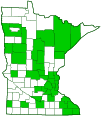brown stink bug
(Euschistus servus)
Conservation • Description • Habitat • Ecology • Distribution • Taxonomy
Conservation Status |
|
|||||||
| IUCN Red List | not listed |
|||||||
| NatureServe | not listed |
|||||||
| Minnesota | not listed |
|||||||
Description |
||
Brown stink bug is a common, medium-sized, stinkbug. It occurs across the United States, southern Canada, and northern Mexico. It is common in Minnesota. There are two subspecies of Euschistus servus. Only E. s. euschistoides, the northern subspecies, is found in Minnesota. It can be a serious agricultural pest. The head is small and narrow, much narrower than the thorax. It is tucked into a concave groove in the margin of the pronotum. There is no visible “neck” when viewed from above. There are two large, bulging, compound eyes and two small simple eyes (ocelli). There is no crosswise (transverse) groove between the compound eyes. The mouth parts are optimized for piercing and sucking, and take the form of a thick, curved, 3-segmented beak (rostrum). The rostrum is longer than the head and fits into a groove on the underside (sternum) when not in use. The antennae are exposed, conspicuous, slender, and long, much longer than the head but not as long as the body. They have five segments. The first segment is thicker than the second. The fifth segment and the last (apical) half of the fourth segment are dark brown to black. The remainder is orangish or reddish. The body is shield-shaped, ⅜″ to 9 ⁄16″ (10 to 14 mm) long, and 1 ⁄16″ to ⅛″ (7 to 8.5 mm) wide. The upperside is grayish-yellow, hairless, and densely covered with dark brown punctures. The exoskeletal plate covering the thorax (pronotum) is wide, giving the body a broad-shouldered appearance. The angles in the shoulder (humeral) area on each side are rounded and have no projecting tooth. The lateral margins toward the front are scalloped to toothed. There are two pairs of wings, and they are held flat over the body when at rest. Between and at the wing bases there is a triangular plate (scutellum). The forewings (hemelytra) on the mature adult are as long as the abdomen but do not completely cover the sides of the abdomen. The sides of the abdomen are exposed and appear conspicuously striped when the wings are closed. The hemelytra have a thickened section at the base and a thin membranous section at the tip with a clear dividing line between the two. The thickened basal part is comprised of a narrow area (clavus) behind the scutellum when the wings are closed, and the remaining broad marginal area (corium). The scutellum is triangular and large, covering about half of the abdomen, but is not longer than the corium, and not reaching the tip of the abdomen. The tip of the scutellum is white or yellow and is mostly free of punctures. There is a dark spot, more a smudge, in the middle of the scutellum, and a similar spot in the middle of each corium. The spots are diffuse and may be barely visible. The hindwings are thin, membranous, and concealed under the forewings. The underside of the body is pale, usually with a pinkish tinge, and contrasting sharply with the dark upper side. There are one to four black spots on the underside in the middle (medial) of the abdomen. The legs are pale. The fourth segment of the hind leg (tibia) is grooved above. It does not have spines. The last part of the leg (tarsus), corresponding to the foot, has 3 segments. |
||
Size |
||
Total length: ⅜″ to 9 ⁄16″ (10 to 14 mm) |
||
Similar Species |
||
Habitat |
||
|
||
Ecology |
||
Season |
||
Two generations per year. May to November |
||
Behavior |
||
|
||
Life Cycle |
||
Adults overwinter in leaf and plant litter. The female lays clusters of 14 kettle-shaped eggs in tight rows on the underside of leaves. |
||
Nymph Food |
||
|
||
Adult Food |
||
|
||
Distribution |
||||
|
Sources |
|||
| 10/28/2022 | ||||
Occurrence |
||||
Common |
||||
Taxonomy |
|||
Order |
Hemiptera (True bugs, Hoppers, Aphids, and Allies) | ||
Suborder |
Heteroptera (True Bugs) | ||
Infraorder |
Pentatomomorpha | ||
Superfamily |
Pentatomoidea (stink bugs, shield bugs, and allies) | ||
Family |
|||
Subfamily |
Pentatominae | ||
| Tribe | Carpocorini | ||
Genus |
Euschistus (brown stink bugs) | ||
Subgenus |
Euschistus | ||
Subordinate Taxa |
|||
brown stink bug (Euschistus servus euschistoides) brown stink bug (Euschistus servus servus) |
|||
Synonyms |
|||
|
|||
Common Names |
|||
brown stink bug |
|||
Glossary
Corium
The thickened basal portion of the front wing that lies between the clavus and the membrane of insects in the family Hemiptera. Plural: coria.
Hemelytron
The forewing of true bugs (order Hemiptera), thickened at the base and membranous at the tip. Plural: hemelytra.
Ocellus
Simple eye; an eye with a single lens. Plural: ocelli.
Pronotum
The exoskeletal plate on the upper side of the first segment of the thorax of an insect.
Rostrum
The stiff, beak-like projection of the carapace or prolongation of the head of an insect, crustacean, or cetacean.
Scutellum
The exoskeletal plate covering the rearward (posterior) part of the middle segment of the thorax in some insects. In Coleoptera, Hemiptera, and Homoptera, the dorsal, often triangular plate behind the pronotum and between the bases of the front wings. In Diptera, the exoskeletal plate between the abdomen and the thorax.
Tarsus
On insects, the last two to five subdivisions of the leg, attached to the tibia; the foot. On spiders, the last segment of the leg. Plural: tarsi.
Tibia
The fourth segment of an insect leg, after the femur and before the tarsus (foot). The fifth segment of a spider leg or palp. Plural: tibiae.
Visitor Photos |
|||||
Share your photo of this insect. |
|||||
| This button not working for you? Simply email us at info@MinnesotaSeasons.com. Attach one or more photos and, if you like, a caption. |
|||||
Alfredo Colon |
|||||
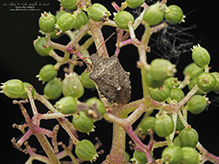 |
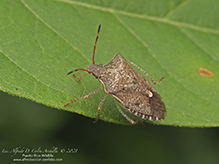 |
||||
 |
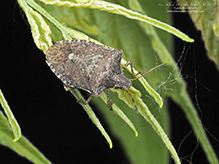 |
||||
Luciearl |
|||||
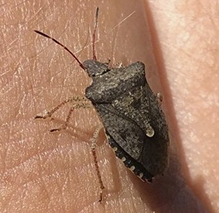 |
|||||
MinnesotaSeasons.com Photos |
|||||
|
|||||

Visitor Videos |
|||
Share your video of this insect. |
|||
| This button not working for you? Simply email us at info@MinnesotaSeasons.com. Attach a video, a YouTube link, or a cloud storage link. |
|||
Other Videos |
|||
| Brown Stinkbug (Euschistus servus servus) Nature in Motion |
|||
About
Oct 17, 2016 The under-wing of this "pest" is quite beautiful as shown in the 1st clip, which is in slow motion. Note the water bubble in the 2nd clip. Host plant: They are found on a variety of plants such as legumes, vines, and cultivated crops. This one was on Beautyberry. Brown Stinkbugs do not eat other insects. Pentatomomorpha » Pentatomoidea » Stink Bugs (Pentatomidae) » Pentatominae » Carpocorini » Euschistus » Brown Stink Bug (Euschistus servus) » Euschistus servus servus Music: Kickin It |
|||
| Brown Stink Bug (Pentatomidae: Euschistus?) on Leaf Carl Barrentine |
|||
About
Aug 5, 2010 Photographed at Turtle River State Park, North Dakota (04 August 2010). |
|||


Created: 1/302020
Last Updated:
